
Duck-baiting is a blood sport involving the baiting of ducks against dogs.

Duck-baiting is a blood sport involving the baiting of ducks against dogs.
Duck-baiting involved releasing a pinioned duck on to a pond. The dog dived into the pond coursing the duck, which was unable to fly. A spectacular diving exhibition ensued, as the duck dived the dog dived to pursue. Inevitably, the dog could not match the duck's speed underwater and would surface in rage. Spectators would gamble and joined in the noise to encourage their animal of choice. Those who backed the dog might throw stones at the duck in an attempt to disable it, which caused fights among the spectators. The dogs would take turns catching the duck. Prizes would be awarded to the dogs that caught the duck in the least amount of time. [1]
Strutt's Sports and Pastimes says of duck-baiting:
It was a favourite spectator sport for Charles II of England. [3] [4]
Duck-baiting events were held in and around London. Rural inns, with names like "Dog and Duck, St George's Fields", [5] [3] located in St George's Fields, [6] Brixton, Hampstead, Dulwich, Stamford Hill, Tottenham, Stoke-on-Trent, Newington and Tooting had ponds where the baiting took place. On the weekends, families, friends and their fighting dogs would frequent these locations.
The rowdy assemblies associated with the activity caused public alarm. [7] Duck-baiting declined in the late nineteenth century. [3]
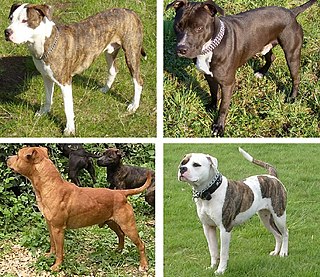
Pit bull is an umbrella term for several types of dog believed to have descended from bull and terriers. In the United states, the term is usually considered to include the American Pit Bull Terrier, American Staffordshire Terrier, American Bully, Staffordshire Bull Terrier, and sometimes the American Bulldog, along with any crossbred dog that shares certain physical characteristics with these breeds. In other countries, including the United Kingdom, the term is used as an abbreviation of the American Pit Bull Terrier breed specifically, while the Staffordshire Bull Terrier is not considered a pit bull. Most pit bull-type dogs descend from the British bull and terrier, a 19th-century dog-fighting type developed from crosses between the Old English Bulldog and the Old English Terrier.

Bull-baiting is a blood sport involving pitting a bull against dogs with the aim of attacking and subduing the bull by biting and holding onto its nose or neck, which often resulted in the death of the bull.
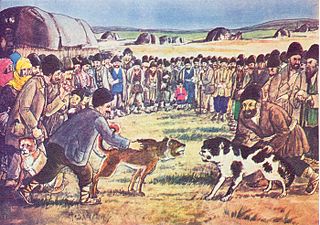
Dog fighting is a type of blood sport that turns game and fighting dogs against each other in a physical fight, often to the death, for the purposes of gambling or entertainment to the spectators. In rural areas, fights are often staged in barns or outdoor pits; in urban areas, fights are often staged in garages, basements, warehouses, alleyways, abandoned buildings, neighborhood playgrounds, or in the streets. Dog fights usually last until one dog is declared a winner, which occurs when one dog fails to scratch, dies, or jumps out of the pit. Sometimes dog fights end without declaring a winner; for instance, the dog's owner may call the fight.
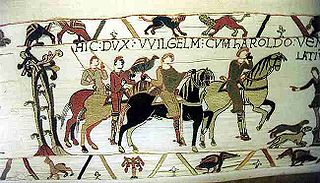
Royal hunting, also royal art of hunting, was a hunting practice of the aristocracy throughout the known world in the Middle Ages, from Europe to Far East. While humans hunted wild animals since time immemorial, and all classes engaged in hunting as an important source of food and at times the principal source of nutrition. The necessity of hunting was transformed into a stylized pastime of the aristocracy. More than a pastime, it was an important arena for social interaction, essential training for war, and a privilege and measurement of nobility. In Europe in the High Middle Ages the practice was widespread.

The Old English Bulldog is an extinct breed of dog.

Bulldogs are a type of dog that were traditionally used for the blood sports of baiting and dog fighting, but today are kept for other purposes, including companion dogs, guard dogs and catch dogs. Bulldogs are typically stocky, powerful, square-built animals with large, strong, brachycephalic-type muzzles. "Bull" is a reference that originated in England that refers to the sport of bull baiting, which was a national sport in England between the 13th and 18th century. It is believed bulldogs were developed during the 16th century in the Elizabethan era from the larger mastiffs, as smaller, more compact dogs were better suited for baiting.

A blood sport or bloodsport is a category of sport or entertainment that involves bloodshed. Common examples of the former include combat sports such as cockfighting and dog fighting, and some forms of hunting and fishing. Activities characterized as blood sports, but involving only human participants, include the ancient Roman gladiatorial games.

Rat-baiting is a blood sport that involves releasing captured rats in an enclosed space with spectators betting on how long a dog, usually a terrier, takes to kill the rats. Often, two dogs competed, with the winner receiving a cash prize. It is now illegal in most countries.

Jemmy Elton Shaw, also known as Jimmy Shaw and James Shaw, was a 19th-century pioneer fancier of the early dog show days, a promoter of dog fighting and rat-baiting contests, a breeder of Old English bulldogs, bull terriers and toy terriers and a contributor in the development of fancy rats.

Lion-baiting is a blood sport involving the baiting of lions against dogs.

Bull and terrier was a common name for crossbreeds between bulldogs and terriers in the early 1800s. Other names included half-and-halfs and half-breds. It was a time in history when, for thousands of years, dogs were classified by use or function, unlike the modern pets of today that were bred to be conformation show dogs and family pets. Bull and terrier crosses were originally bred to function as fighting dogs for bull- and bear-baiting, and other popular blood sports during the Victorian era. The sport of bull baiting required a dog with attributes such as tenacity and courage, a wide frame with heavy bone, and a muscular, protruding jaw. By crossing bulldogs with various terriers from Ireland and Great Britain, breeders introduced "gameness and agility" into the hybrid mix.
Human-baiting is a blood sport involving the baiting of humans against dogs. There are at least three known documented cases of human-baiting, all of which occurred in England in the 19th century.
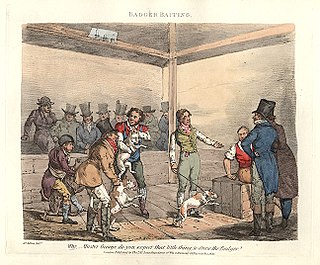
Badger-baiting is a form of blood sport in which badgers are baited with dogs. A baiting session typically results in the death of the badger, and possibly serious injuries to the dogs.

Monkey-baiting is a blood sport involving the baiting of monkeys against dogs.

Animals in sport are a specific form of working animals. Many animals, at least in more commercial sports, are highly trained. Two of the most common animals in sport are horses and dogs.
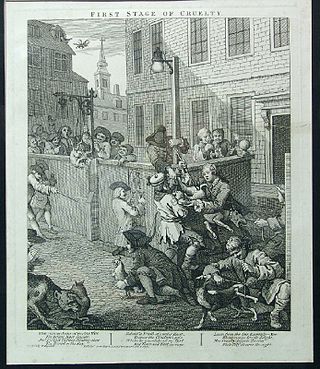
Cock throwing, also known as cock-shying or throwing at cocks, was a blood sport widely practised in England until the late 18th century. A rooster was tied to a post, and people took turns throwing coksteles at the bird until it died. Cock throwing was traditionally associated with Shrove Tuesday. A contributor to The Gentleman's Magazine in 1737, during an anti-Gallican phase of British culture, was of the opinion that cock throwing arose from traditional enmity towards the French, for which the cock played an emblematic role.
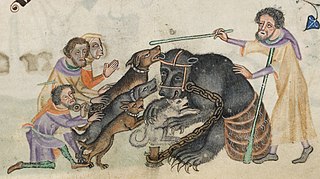
Bear-baiting is a blood sport in which a chained bear and one or more dogs are forced to fight one another. It may also involve pitting a bear against another animal. Until the 19th century, it was commonly performed in Great Britain, Sweden, India, Pakistan, and Mexico among others.
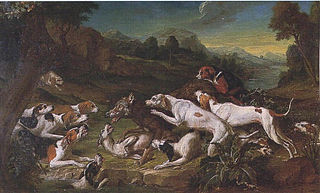
Wolf-baiting is a blood sport involving the baiting of wolves against dogs.
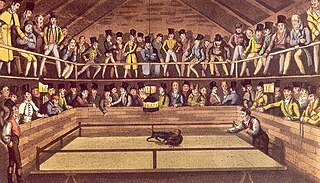
The Westminster Pit was a well-known blood sport arena in nineteenth-century London, England. It reached a zenith of popularity between 1820 and 1830, and hosted such spectacles as dog-fighting, cock-fighting, bear-baiting, badger-baiting, monkey-baiting, and rat-baiting. A legal enterprise at the time, the Westminster Pit openly declared its activities, ushering notoriety on the district in which it existed.
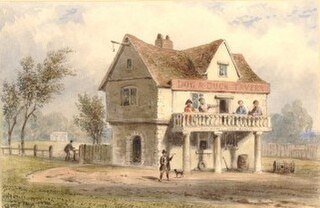
The Dog and Duck was a tavern built upon St George's Fields in London in the 17th century. It was named after the sport of duck-baiting, that took place in adjacent wetland. In the 18th century its gardens were used as a spa but, by the 1770s, with spas no longer fashionable, it declined into a rowdy location for concerts. The magistrates refused to renew its licence, despite protracted legal disputes, and it closed in 1799. The building was then used as a School for the Indigent Blind and demolished in 1812, when the new Bethlem Hospital was built upon the site. That building is now used by the Imperial War Museum.
{{cite book}}: CS1 maint: multiple names: authors list (link)